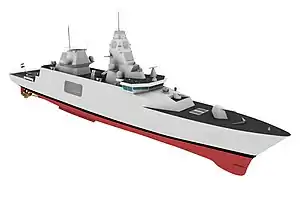Anti-Submarine Warfare Frigate (Koninklijke Marine)
The Anti-Submarine Warfare Frigate (ASWF) is a project of the Royal Netherlands Navy (RNLN, Dutch: Koninklijke Marine) and Belgian Navy to replace the existing Multipurpose- or M-frigates.[1] The project shows similarities to the British Global Combat Ship (also formerly named FSC program) but development is fully separate.
 Artist impression of the ASWF | |
| Class overview | |
|---|---|
| Name | Anti-Submarine Warfare Frigate |
| Builders | Damen Schelde Naval Shipbuilding |
| Operators | |
| Preceded by | Karel Doorman-class frigate |
| Cost | Around €4 billion for 4 ships |
| Built | 2020–2030s |
| Planned | 4 |
| General characteristics | |
| Displacement | 6.400 tonnes |
| Length | 145 meters |
| Beam | 17+ meters |
| Complement | up to 117 (plus space for additional 34) |
| Sensors and processing systems |
|
| Armament |
|
| Aircraft carried | |
Context
The current M-frigates, originally all built in the Netherlands but apart from two units sold to Belgium, Portugal, and Chile are reaching their planned retirement age around 2020. However, due to extensive budget cuts over the past decades and other large materiel programs such as the acquisition of the F-35 for the Royal Netherlands Air Force, the Dutch Ministry of Defense currently has not enough funds available to start building the ships.[2] Therefore, lifespan of the current vessels has been extended until 2025. Keeping the ships any longer will cause problems with NATO and related tasks because the ships weapons suite is outdated and not up to current standards. For example: the M-frigates only carry 16 surface-to-air missiles in the form of the outdated NATO Sea Sparrow (RIM-7). Onboard recent ships the Evolved Sea Sparrow (Block 2 in development) does the job, but those do not fit in the also outdated Mk48 VLS cells on board the M-frigates. Apart from these, M-frigates only have a single Goalkeeper system for CIWS. Offensive, capabilities are limited to obsolete RGM-84 Harpoon missiles. The 76mm cannon is not fit for modern semi-guided munitions like DART, Davide/STRALES, or VULCANO.[3]
Additionally; the RNLN searched for European partners to build the ships with and cut costs, and in January 2017 reached an agreement with the Belgian Marine Component to build a total of four ships together.[4] This number could be adjusted later on during next phases of the acquisition process. With a total of four and two for the RNLN the current two M-frigates are to be replaced by an equal number. There are concerns about whether that number is enough to meet current and near future challenges, since it often happens the RNLN has no ships available to only fulfill the most basic of its duties (like supporting foreign navy ships along the Dutch coast).[5] The costs for the 4 ships are currently estimated at 1.50-2.50 billion euro's for the two Dutch frigates and 1 billion euro's for the two Belgian frigates.[1] Originally it had been hoped that the first frigate would be delivered to the Royal Netherlands Navy in 2024, while the first frigate for the Belgian Navy was to be delivered in 2027.[6] However, as of 2020, the in-service date for the two Dutch frigates had slipped to 2028-29 with the Belgian frigates following immediately thereafter.[7] In March 2023, the Dutch Ministry of Defense announced that it expected to deploy the first frigate in 2029, with Belgium deploying their first in 2030. The other two remaining frigates would be deployed in the following years.[8]
Specifications
In June 2020, the Dutch Ministry of Defence sent a letter to parliament, which included information about the specifications and capacities of the new frigates[9]
Crew: up to 110 (with space for an additional 40)
Weapon Systems:
- OTO Melara 76 mm Sovraponte capable of firing guided ammunition
- 2 Mark 41 Vertical Launching System 16 cells for anti-air missiles
- quadpacked RIM-162 Evolved Sea Sparrow Missile Block 2
- autocannon
- Anti-ship missile (Naval Strike Missile)
- Replacement Mk46 Lightweight Torpedo
- Softkill anti-torpedo system
- Hard-kill anti-torpedo torpedo (if available)
- CIWS RAM, RIM-116 Rolling Airframe Missile
- light machine guns
Helicopter: 1 NH90 NFH
Other equipment: Integrated Hull Sonar, Towed Sonar Array, 2 RHIB with MAG guns, Drone Launch Pad
References
- Fiorenza, Nicholas (29 May 2018). "Belgium approves M-frigate replacement". www.janes.com. Archived from the original on 29 May 2018. Retrieved 29 May 2018.
- Kuijpers, Dieuwertje (5 November 2016). "Strategische armoede III: de Nederlandse marine is een zinkend schip" (in Dutch). Follow the Money. Retrieved 12 April 2018.
- Karremann, "Marine wil van twee naar één soort fregat".
- "Nederland vervangt marineschepen samen met België" (in Dutch). Dutch Ministry of Defense. 30 November 2016. Retrieved 12 April 2018.
- Karremann, Jaime (29 March 2018). "Vervanger M-fregatten (België en Nederland)" (in Dutch). marineschepen.nl. Retrieved 12 April 2018.
- Karremann, Jaime (26 May 2018). "Nieuwe fregatten en mijnenjagers: dinsdag ondertekening overeenkomst" (in Dutch). marineschepen.nl. Retrieved 26 May 2018.
- "Dutch MoD clears path for the M-frigates replacement, expects delays". 24 June 2020.
- "Nieuwe Anti Submarine Warfare fregatten vanaf 2029 in de vaart" [New Anti Submarine Warfare frigates to hit the seas from 2029] (Press release) (in Dutch). 3 April 2023. Retrieved 3 April 2023.
- "Resultaten van de onderzoeksfase (B-fase) van het project 'Vervanging M-fregatten'".
Bibliography
- Karremann, Jaime. "Multipurposefregat (M-fregat)" (in Dutch). marineschepen.nl. Retrieved March 6, 2018.
- Karremann, Jaime. "Marine wil van twee naar één soort fregat" (in Dutch). marineschepen.nl. Retrieved March 6, 2018.
- "Boeggolf aan vervangingen" (in Dutch). marineschepen.nl. Retrieved March 6, 2018.
- Oosting, Antoon. "Nieuwbouw marineschepen dreigt ernstig te vertragen" (in Dutch). Maritiem Nederland. Archived from the original on May 7, 2017. Retrieved March 6, 2018.